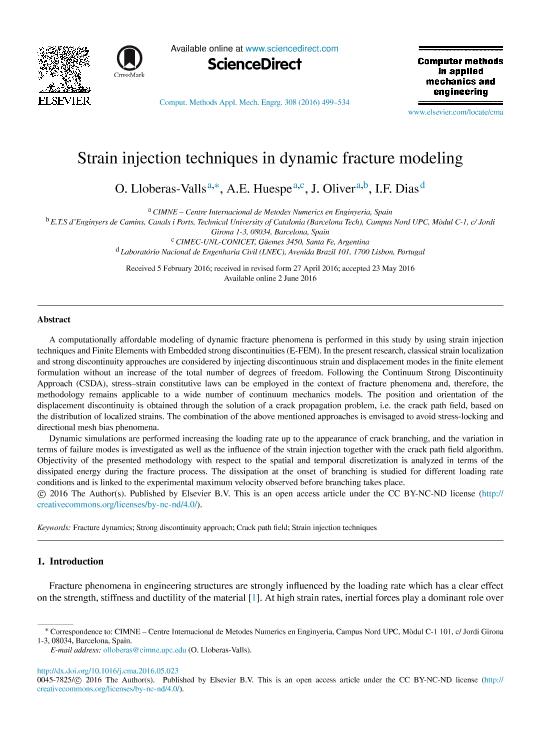Mostrar el registro sencillo del ítem
dc.contributor.author
Lloberas Valls, Oriol

dc.contributor.author
Huespe, Alfredo Edmundo

dc.contributor.author
Oliver, J.
dc.contributor.author
Dias, I.F.
dc.date.available
2018-03-07T21:40:41Z
dc.date.issued
2016-08
dc.identifier.citation
Lloberas Valls, Oriol; Huespe, Alfredo Edmundo; Oliver, J.; Dias, I.F.; Strain injection techniques in dynamic fracture modeling; Elsevier Science Sa; Computer Methods in Applied Mechanics and Engineering; 308; 8-2016; 499-534
dc.identifier.issn
0045-7825
dc.identifier.uri
http://hdl.handle.net/11336/38241
dc.description.abstract
A computationally affordable modeling of dynamic fracture phenomena is performed in this study by using strain injection techniques and Finite Elements with Embedded strong discontinuities (E-FEM). In the present research, classical strain localization and strong discontinuity approaches are considered by injecting discontinuous strain and displacement modes in the finite element formulation without an increase of the total number of degrees of freedom. Following the Continuum Strong Discontinuity Approach (CSDA), stress–strain constitutive laws can be employed in the context of fracture phenomena and, therefore, the methodology remains applicable to a wide number of continuum mechanics models. The position and orientation of the displacement discontinuity is obtained through the solution of a crack propagation problem, i.e. the crack path field, based on the distribution of localized strains. The combination of the above mentioned approaches is envisaged to avoid stress-locking and directional mesh bias phenomena. Dynamic simulations are performed increasing the loading rate up to the appearance of crack branching, and the variation in terms of failure modes is investigated as well as the influence of the strain injection together with the crack path field algorithm. Objectivity of the presented methodology with respect to the spatial and temporal discretization is analyzed in terms of the dissipated energy during the fracture process. The dissipation at the onset of branching is studied for different loading rate conditions and is linked to the experimental maximum velocity observed before branching takes place.
dc.format
application/pdf
dc.language.iso
eng
dc.publisher
Elsevier Science Sa

dc.rights
info:eu-repo/semantics/openAccess
dc.rights.uri
https://creativecommons.org/licenses/by-nc-nd/2.5/ar/
dc.subject
Crack Path Field
dc.subject
Fracture Dynamics
dc.subject
Strain Injection Techniques
dc.subject
Strong Discontinuity Approach
dc.subject.classification
Ingeniería Mecánica

dc.subject.classification
Ingeniería Mecánica

dc.subject.classification
INGENIERÍAS Y TECNOLOGÍAS

dc.title
Strain injection techniques in dynamic fracture modeling
dc.type
info:eu-repo/semantics/article
dc.type
info:ar-repo/semantics/artículo
dc.type
info:eu-repo/semantics/publishedVersion
dc.date.updated
2018-03-07T15:53:54Z
dc.journal.volume
308
dc.journal.pagination
499-534
dc.journal.pais
Países Bajos

dc.description.fil
Fil: Lloberas Valls, Oriol. Universidad Politecnica de Catalunya; España. Centre Internacional de Metodes Numerics en Enginyeria; España
dc.description.fil
Fil: Huespe, Alfredo Edmundo. Centre Internacional de Metodes Numerics en Enginyeria; España. Consejo Nacional de Investigaciones Científicas y Técnicas. Centro Científico Tecnológico Conicet - Santa Fe. Centro de Investigaciones en Métodos Computacionales. Universidad Nacional del Litoral. Centro de Investigaciones en Métodos Computacionales; Argentina
dc.description.fil
Fil: Oliver, J.. Centre Internacional de Metodes Numerics en Enginyeria; España. Universidad Politecnica de Catalunya; España
dc.description.fil
Fil: Dias, I.F.. Laboratório Nacional de Engenharia Civil; Portugal
dc.journal.title
Computer Methods in Applied Mechanics and Engineering

dc.relation.alternativeid
info:eu-repo/semantics/altIdentifier/doi/http://dx.doi.org/10.1016/j.cma.2016.05.023
dc.relation.alternativeid
info:eu-repo/semantics/altIdentifier/url/https://www.sciencedirect.com/science/article/pii/S0045782516304248
Archivos asociados
